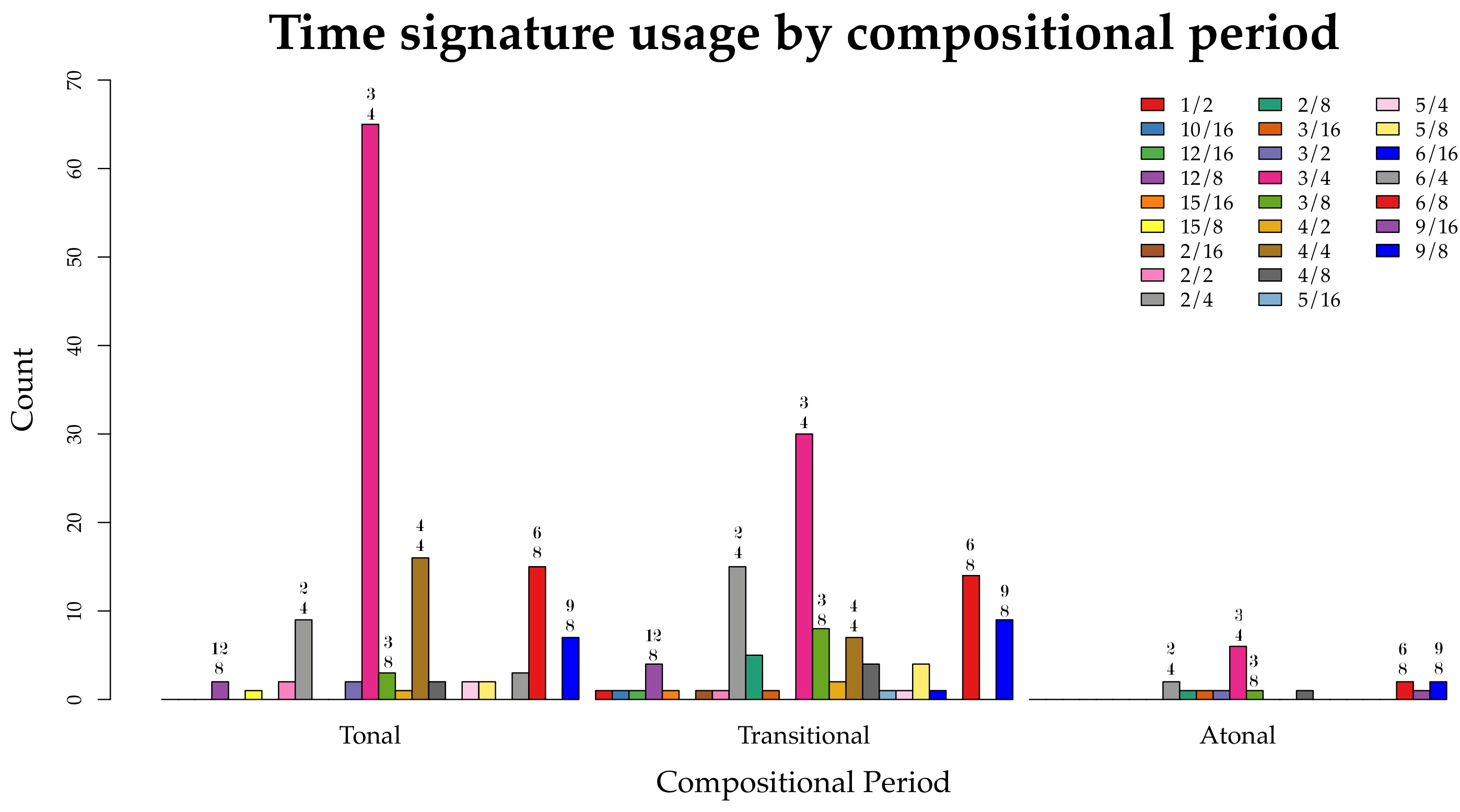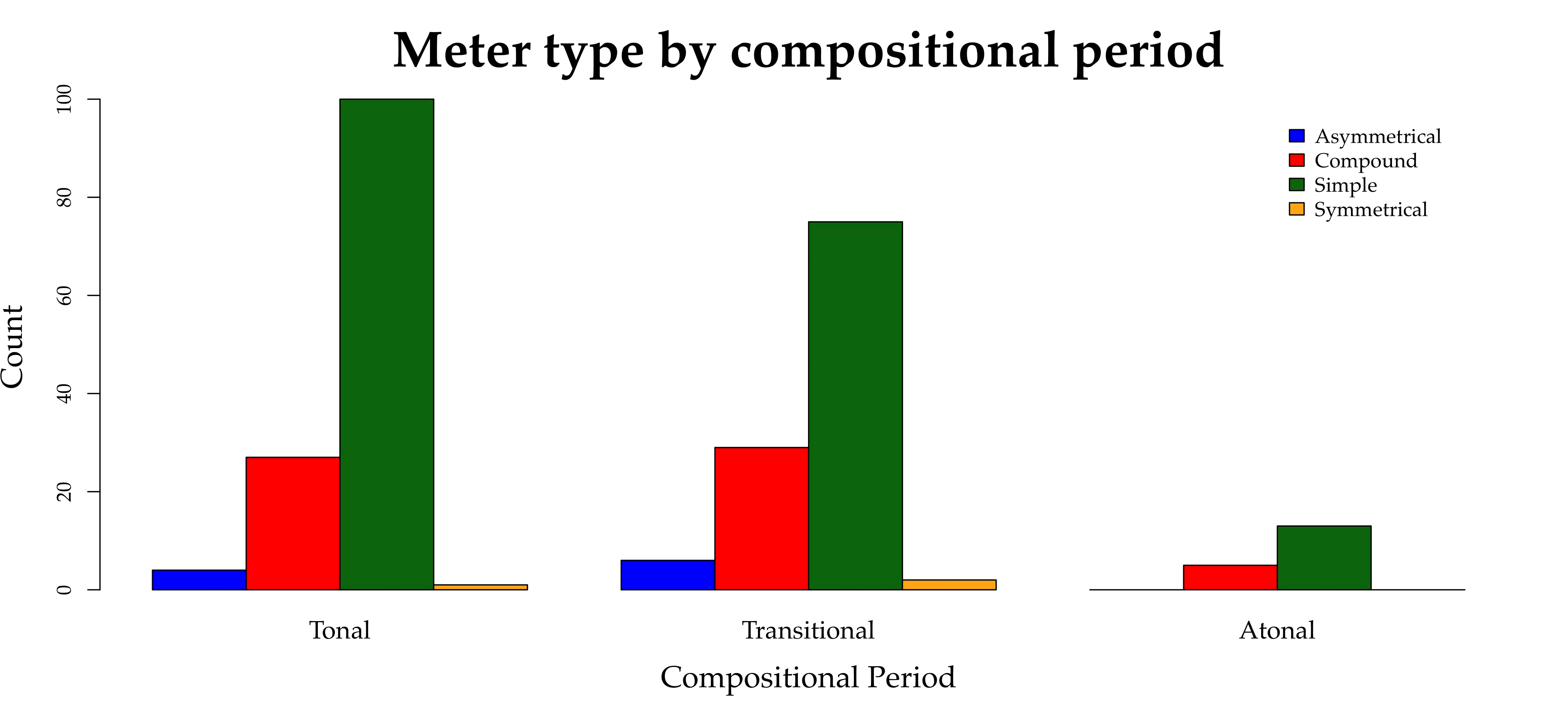AS multiple authors have pointed out, many of the exciting early advances in computational musicology have been built on the foundation of a few important but stylistically limited corpora (London, 2022; Savage, 2022; London, 2013). While the number of new corpora coming online has dramatically increased recently, several of these new datasets extend the focus on common-practice tonal music (e.g., Neuwirth et al., 2018; Devaney et al., 2015) while several others focus on broadening corpora to include popular music (e.g., de Clercq, 2022; Moss et al., 2020). One important stylistic era that is still lacking in deep representation is the overlapping periods of late Romanticism and early post-tonality, approximately 1880–1920. The music of this era is both disparate and complex, often comprising blends of tonal and post-tonal harmonies and using methods of rhythmic and metric organization that are idiosyncratic to individual composers (Cohn, 2012; Samson, 1977). Nevertheless, this era continues the longstanding tradition of Western musical notation, making its music a natural candidate for inclusion into use for symbolic music corpora.
This article presents a new corpus that intends to fill this gap. The Mysterium corpus comprises the entirety of the solo piano music of Alexander Scriabin. It comprises 207 pieces composed from 1885–1914 and, apart from a few symphonic pieces and some juvenilia, comprises almost all of Scriabin's music. The name Mysterium comes from a large-scale, multi-sensory composition that Scriabin left unfinished upon his death, and alludes to the mystical qualities that people often associate with the enigmatic composer and his late music. The Mysterium corpus is one component of a larger research project, presented as a Master's thesis, An Inner Metric Analysis of Meter in the Music of Alexander Scriabin (Bell, 2022).
ENCODING PROCESS
Despite Scriabin's use of largely conventional musical notation, the process of encoding his solo piano music into a digital symbolic representation is not straightforward. For this project, we elected to encode the dataset in Humdrum's kern representation (Huron, 2002) due to the flexibility of its representation to overcome certain challenges within the corpus and the availability of analytical programs. The dataset is available at the following GitHub repository: https://github.com/bel28kent/Mysterium.
There were two inclusion criteria for the Mysterium corpus: (1) the piece must have had an opus number and have been published during Scriabin's lifetime, and (2) Scriabin must have composed the piece for solo piano. As a result of (1), juvenilia, sketches, and unfinished pieces are not present in the corpus. As a result of (2), there are a handful of symphonic pieces that are absent from the corpus. Specifically missing are the five symphonies (Opp. 26, 29, 43, 54, 60), the piano concerto (Op. 20), and the orchestral prelude Rêverie (Op. 24). Despite these missing works, the Mysterium corpus almost fully captures the composer's output in a single dataset, given Scriabin's status as primarily a virtuoso pianist-composer in the same vein as Chopin.
Scriabin's published output is listed as Opp. 1–74. (Note that Scriabin did not publish with the opus numbers 50 or 55.) Several of these works are multi-movement piano sonatas or collections of individual pieces, such as Prelude sets or Mazurka sets, resulting in a total of 207 individual works, movements, or pieces within larger sets. Works were encoded in random order to prevent introducing systematic errors into the corpus. The 207 pieces were randomized using random.org (Haahr, 2022), and encoded in that order.
Before encoding the music, high-quality editions were identified. The Petrucci Music Library (IMSLP) provides a convenient repository for various editions of Scriabin's output. However, there are sometimes editorial differences between different publishers, and these differences can have a significant impact on the music. Generally—based on our informal assessment—first editions by Scriabin's publishers P. Jurgenson and Mitrofan Belaieff were plagued with various printing and editing typos, including missing accidentals, ties, dots, and other minor issues. This is anecdotally supported by an examination of errata listed in the beginnings of scores reprinted by P. Jurgenson (see Yekimovsky, 1997). When possible, works were taken instead from Günter Philipp's Ausgewählte Klavierwerke, assembled between (1967–1972). Not only were these the most recent editions available on IMSLP, but they were more reliable than older editions. When IMSLP did not provide Philipp's edition for a piece, the edition by Igumnov and Milstein (1948) was used, also because this edition was more reliable than earlier options. When IMSLP provided neither of these editions, whatever available score was encoded. This was rare, but when it happened first editions were typically the only editions available. Table 1 below lists frequency distributions for each of the most recent editions of Scriabin's works available on IMSLP.
| Edition | Number of opuses available for | Percentage of opuses available for |
|---|---|---|
| GP | 39 | 60% |
| IM | 15 | 23% |
| MB | 5 | 8% |
| PJ | 4 | 6% |
| OM | 2 | 3% |
| Total: | 65 | 100% |
Note: GP = Günter Philipp; IM = Konstantin Igumnov and Yakov Milstein; MB = Mitrofan Belaieff; PJ = P. Jurgenson; OM = Lev Oborin and Yakov Milstein. N.B., Igumnov, Milstein, and Oborin were all editors at Muzgiz, or the Soviet State Music Publishing House, in the 1940s, and their work together represents the same edition.
Encoding took place in four folds. First, notes and rhythms were entered into the notation software Finale (version 26.1.643). A second pass by the same encoder involved direct comparisons between the Finale score and the published PDF, checking for accuracy and fixing any found errors. Once checked, the score was exported to a MusicXML file and converted to kern using the musicxml2hum tool (Sapp, 2017b). As a last check, the kern file was imported into Verovio Humdrum Viewer (VHV; Sapp, 2017a) and comparisons between the kern file and the rendered score were examined for any conversion errors. If an error was found, the kern file was updated in VHV and then exported as a new kern file. Rarely, the musicxml2hum tool threw a segmentation fault error when used; when this happened, the MusicXML file was imported directly into VHV and then exported using the "Convert to Humdrum" option.
The process of encoding revealed some features of Scriabin's music, especially in regard to his use of rhythm and meter, that were either necessary or more efficient to encode directly into kern. For example, the Finale tremolo tool only encodes the pitch at the notated rhythmic value instead of dividing that value into the sounded rhythm, which is necessary for kern logic. (For example, two quarter notes with three tremolo marks between them signifies a heard thirty-second note alternation between the two notes. The actual thirty-second-note rhythm is requisite in kern.) Complex tuplets (especially when on one staff with other voices) and beaming across the bar are not necessary to encode in kern, but it is much easier to do so. While Finale is very powerful, the software does not automatically format the score in a way that engenders fast editing and error-checking. Complex tuplets and cross-bar beams are particularly messy in Finale. In less time than it takes to manually adjust the Finale score, the same information can be manually encoded directly into kern.
Other features of Scriabin's music require changes when being converted from the score to kern. Some of these changes are small. For instance, a note must be added to a voice in kern when, on the score, a tie is drawn between two noteheads in different voices. See Figure 1 for a simple example of this.
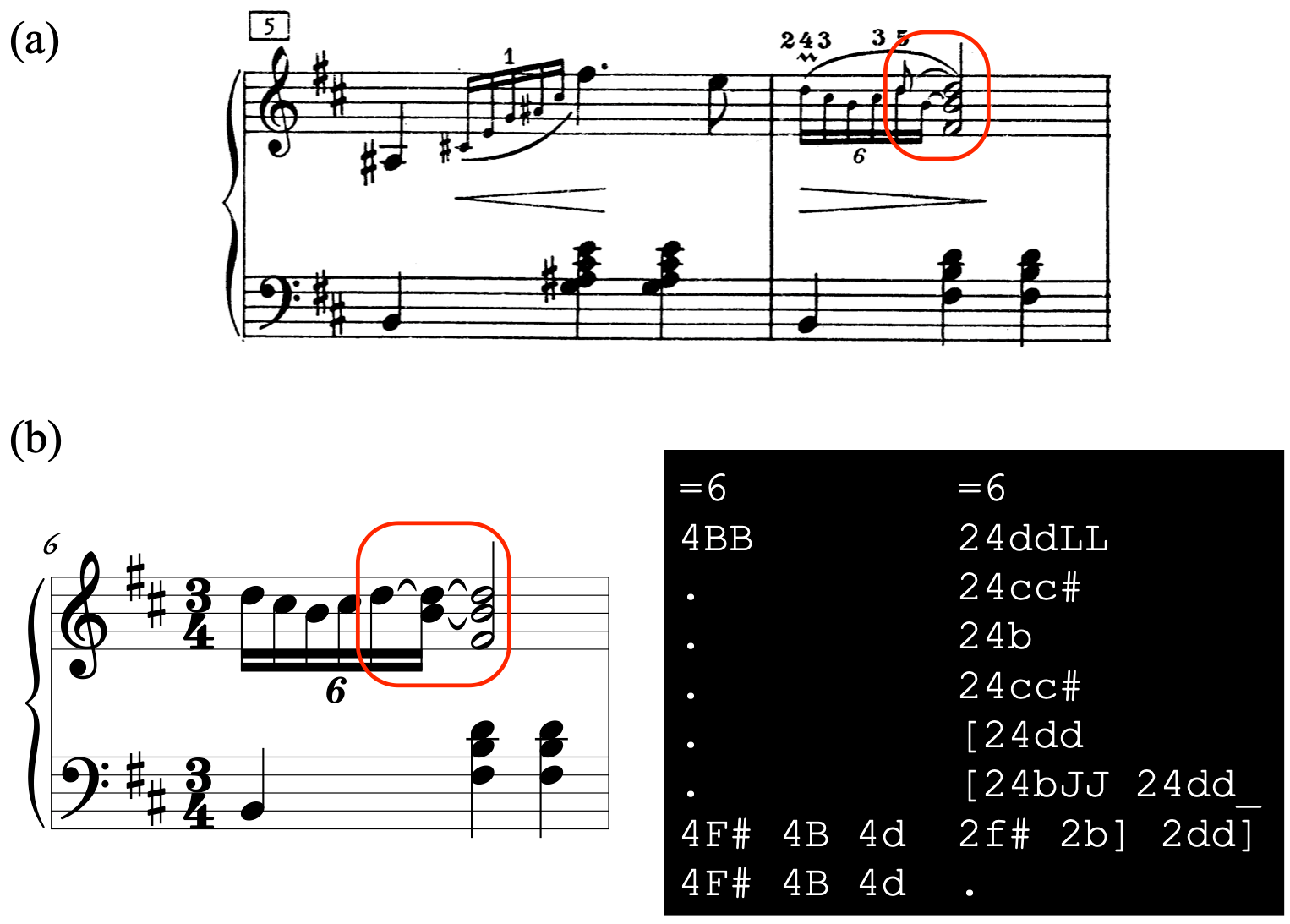
Fig. 1. (a) Scriabin, Op. 3, No. 1, mm. 5–6, original notation showing doubling on D5 with tie over B4. (b) Scriabin, Op. 3, No. 1, m. 6 (left), as encoded in Mysterium, showing repetition of D5 with added tie, and respective Kern encoding (right).
Some changes, however, are more substantive. The primary notation on Scriabin's scores that is problematic in kern is his use of two simultaneous time signatures. In one instance, Scriabin notated time signatures with measures that do not align in a 1:1 ratio. (Sonata No. 6, Op. 62, mm. 330–334 and 365–369; Scriabin notates two 2/8 measures per one 3/8 measure.) In most instances, though, when Scriabin used two competing time signatures, one bar line was drawn through the grand staff, suggesting that each measure lasts for the same duration, and therefore that the two measures are proportionately related. In all such instances, the proportions aligned with 3:2 cross-rhythms. There are no problems in kern when two time signatures' total rhythmic values are equivalent (e.g., 3/4 and 6/8), but when a measure uses two time signatures whose values are not equivalent the score will not render in VHV, as a reflection of the conflicting logic in kern.
There were no "one-size-fits-all" solutions to this type of problem, and so the musical context of each excerpt called for different solutions. Consider, for example, Scriabin's Sonata No. 10, Op. 70, shown in Figure 2. In this excerpt, Scriabin originally chose to simultaneously use 2/4 and 3/8 in mm. 21–22 (Figure 2a). Using these meters, it is necessary to consider the rhythmic values proportionally rather than in relative terms. Since the bar line is drawn through both staves, each 2/4 and 3/8 measure must last for the same length of time. We assign each measure a value of 1, and then work out the proportions to find a 3:2 cross-rhythm between the soprano and tenor voices, indicated by the dashed lines showing the alignment between the two voices. Unfortunately, the original notation is not compatible with the computational approach taken by the kern format. Therefore, in (2b), we have re-notated this polyrhythm in 6/8 (for 2/4) and 3/4 (for 3/8), a notation that both works in kern and is used by Scriabin himself in other works. This notation preserves the duple meter of the right hand and the triple meter of the left hand, but represents the compound subdivisions of the right hand as natural rather than borrowed subdivisions. For detailed notes about every modification made to Scriabin's original notation, along with a rationale, consult the README.md file included on the GitHub repository: https://github.com/bel28kent/Mysterium.
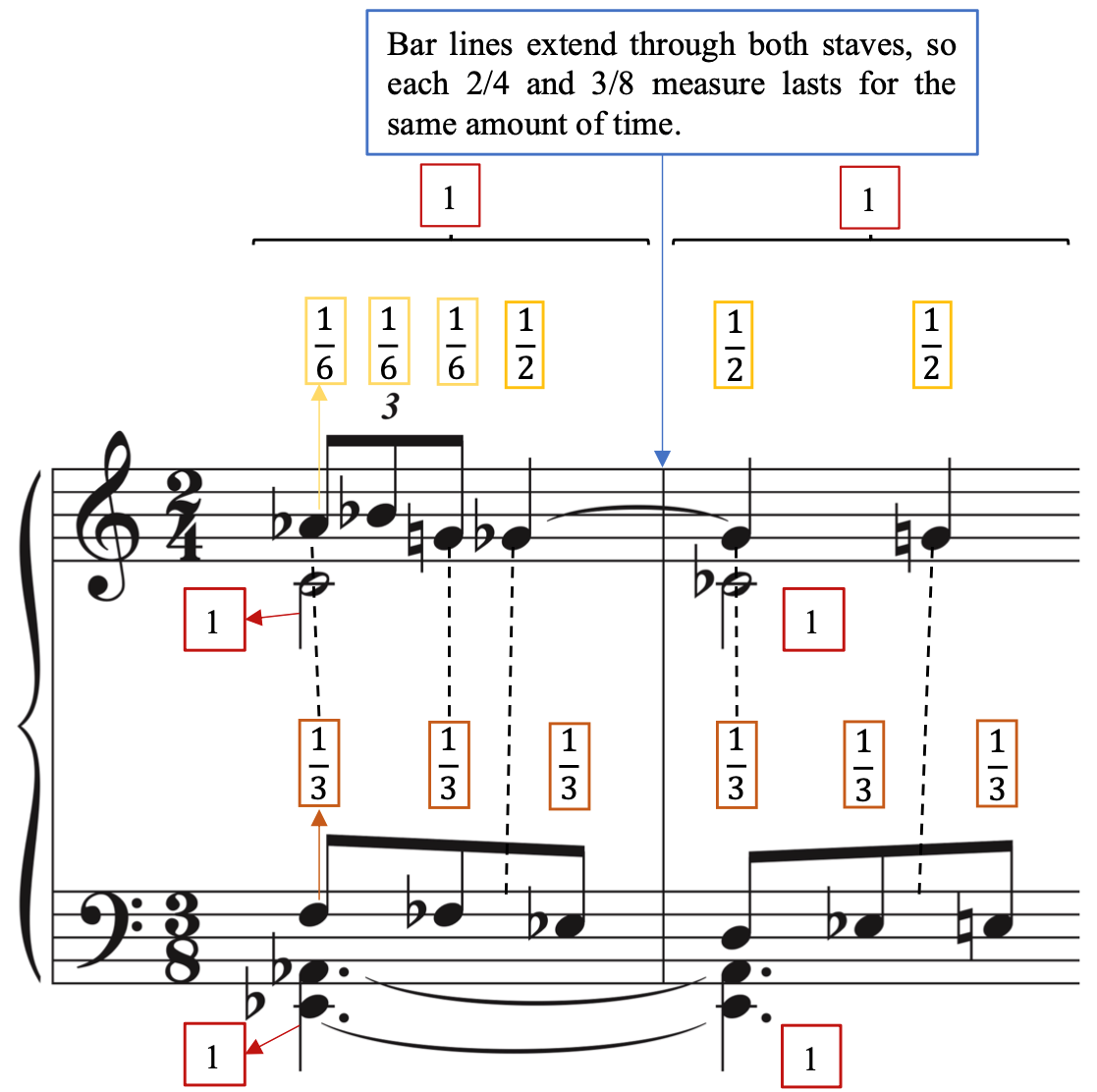
Fig. 2a. Scriabin, Sonata No. 10, Op. 70, mm. 21–22. In Scriabin's original notation, the upper part uses 2/4, and the lower part uses 3/8. We have annotated the score to show the proportional values for each note assuming that each measure equals 1 (see blue box at top first). We also show the composite rhythm necessitated by the proportions using the dashed lines.
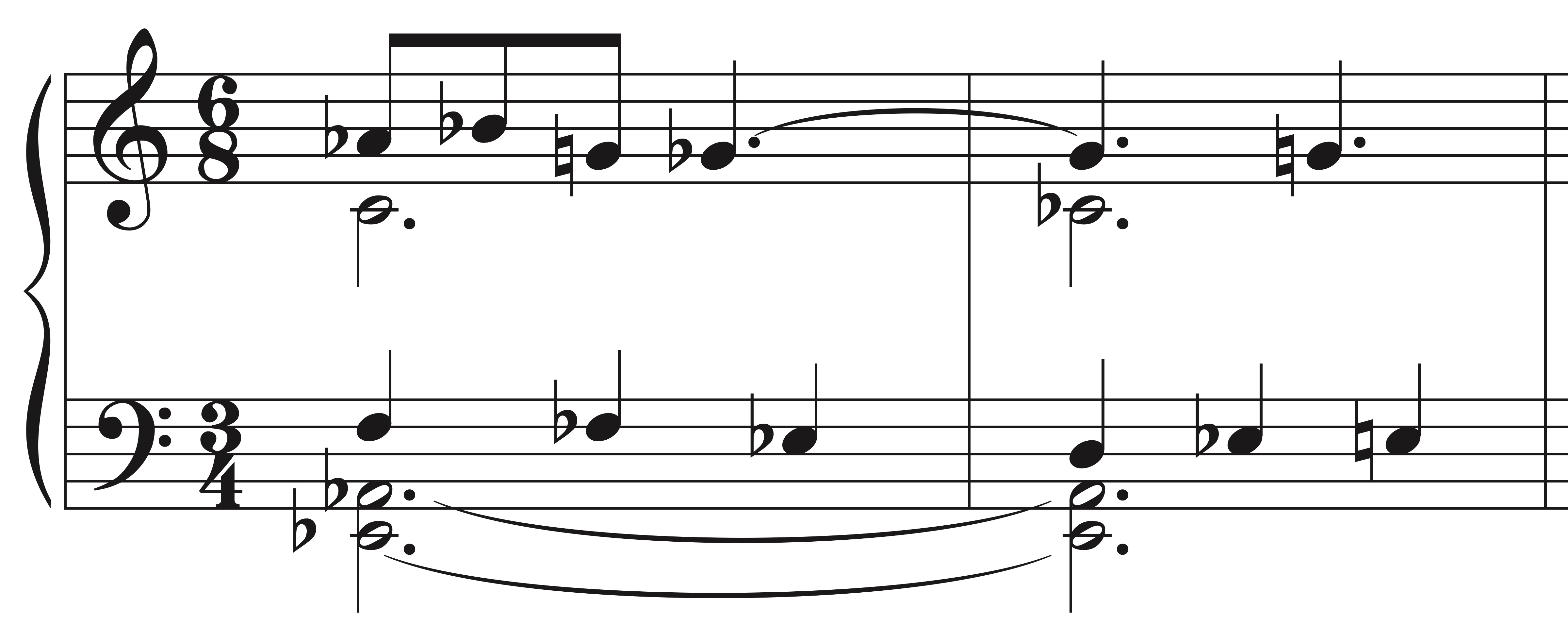
Fig. 2b. Scriabin, Sonata No. 10, Op. 70, mm. 21–22. In our re-notation, the upper part uses 6/8, and the lower part uses 3/4. This notation preserves the proportional relationships between the notes, as well as the use of duple meter on top and triple meter on bottom.
To assist in computational studies, each kern file in the Mysterium corpus includes metadata in the form of standard Humdrum reference records at the beginning, including: composer (!!!COM), title (!!!OTL), title of parent work (!!!OPR), opus number (!!!OPS), work number (!!!ONM), date of composition (!!!ODT), and genre (!!!AGN). See Figure 3 for a representative example of reference records.
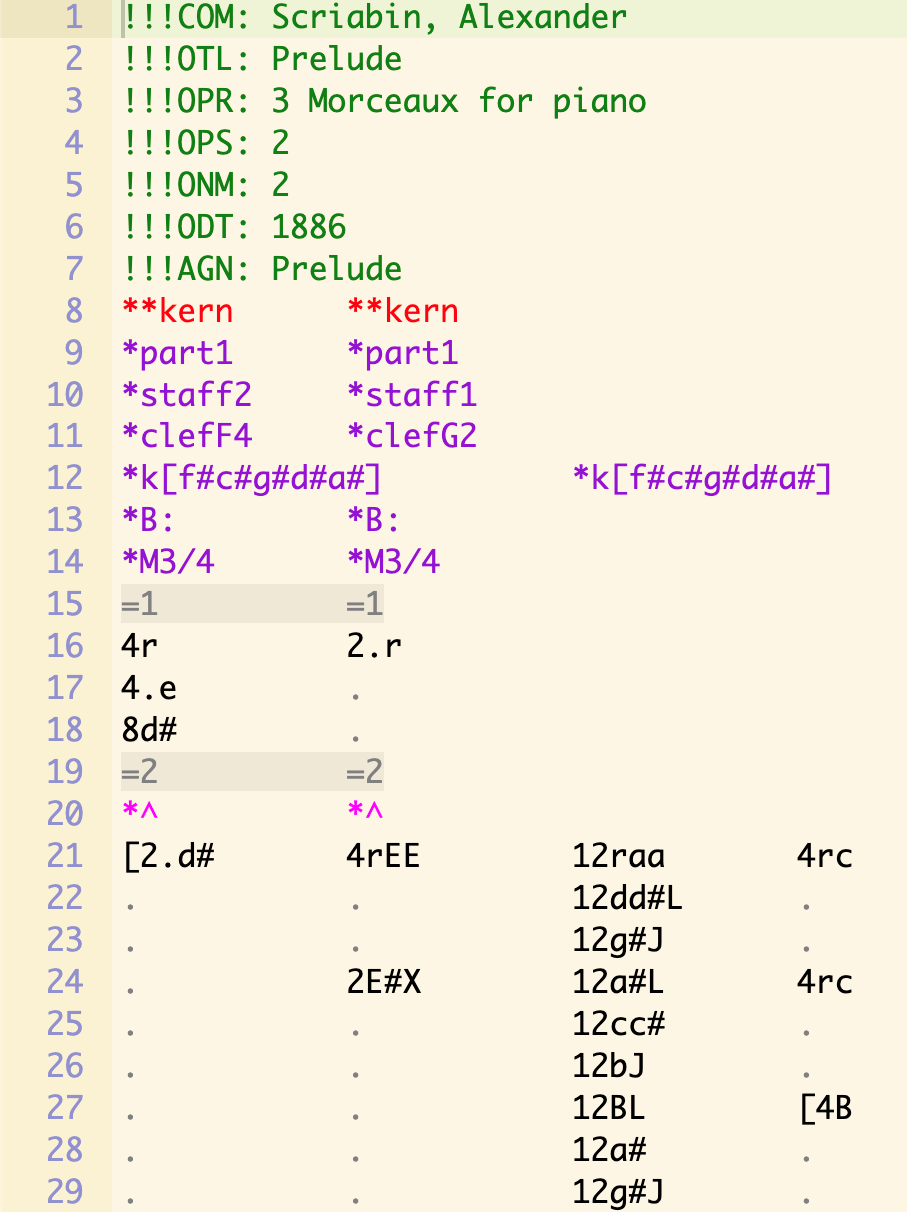
Fig. 3. Scriabin, Prelude from 3 Morceaux pour piano, Op. 2, No. 2, displayed in Verovio Humdrum Viewer, and showing the reference records (Lines 1–7) used in each kern file.
Eleven pieces included in the corpus were already encoded and publicly available on the website of the Center for Computer Assisted Research in the Humanities (KernScores, n.d.). Nevertheless, reference records were added to these pre-existing files, consistent with the style for the corpus. We sourced all dates given in the !!!ODT reference records from Schloezer's (1987) memoir of Scriabin, which includes dates for each composition. At the end of each file, reference records are included regarding the encoder and encoding date (!!!ENC and !!!END, respectively) as well as the editor and edition title (!!!PED and !!!PTL, respectively). Additionally, a directory is included in the GitHub repository (called reference_editions) that contains PDF copies of all editions used for encoding.
For genre, we distinguished between "sonata movement" and "sonata" to reflect, respectively, whether a work is one movement of a larger composition (as is the case with the first four sonatas) or is a single-movement work (as is the case with the last six sonatas). We have treated each sonata movement separately in this corpus, meaning that the first and third sonatas each contributed four movements to the "sonata movement" category and the second and fourth sonatas each contributed two movements.
All key signatures notated in the score were encoded as interpretation records in the kern files, notated using the Humdrum standard *k[], with sharped or flatted notes added within brackets in the order of appearance. This information was consistent with that which appeared in most printed editions. Notated key signature changes were added into the kern file at the proper location.
Somewhat more controversially, we elected to encode key interpretations for only the first key in each work. These keys were assigned by the lead author in the process of encoding through careful observation of the score. These key labels were then matched with key designations provided within the Naxos Music Library database. For example, the Four Preludes, Op. 33 were listed as being in the keys of E major, F-sharp major, C major, and A-flat major, respectively, for the Naxos album Scriabin, Preludes, Vol. 2, with Evgeny Zarafiants as pianist (2000). If the key assigned by the encoder did not match the Naxos album key assignment, then the encoder re-examined the score and confirmed the Naxos album's designation. Key designations were provided for works until around Op. 53, after which Scriabin moved away from a clearly tonal language. For later pieces beyond Op. 53, key designations become increasingly rare. This is because Scriabin's later music progressively embraces an atonal language, and the absence of accidentals reflects no key, not C major or A minor.
DESCRIPTIVE STATISTICS
The main contribution of this article is the encoding of the Mysterium corpus and public access being made available to interested researchers. However, it is also appropriate to offer discussion of some of the basic musical features of the corpus. The following sections provide descriptive statistics regarding the contents of the corpus and include genre distributions, features of Scriabin's meter, and elements of harmony. Below, we outline population distributions, but we also further explore the ways in which Scriabin's music evolved over time.
James Baker (1986) divided Scriabin's compositional output into three periods: tonal (1885–1903), transitional (1903–1913), and atonal (1913–1915). To some extent, any boundaries between periods are by nature arbitrary. Regardless, there are marked shifts in Scriabin's style throughout his career, and there are benefits to observing how his compositional choices evolved in different eras. Though Scriabin's music developed continuously over his career, there are still strong associations between compositional choices and other elements of his philosophy and aesthetics at specific points in his output. For a more comprehensive discussion of the relationship between Scriabin's philosophical ideas and their significance on his music, see Smith (2013). In keeping with the spirit of Baker's designations, we decided to also examine differences between Scriabin's periods, keeping Baker's main temporal cutoffs as approximate boundaries. However, to keep the compositional periods discrete, the year boundaries have been modified: tonal (1885–1902), transitional (1903–1912), and atonal (1913–1915). For a further discussion of the logic underlying period boundaries, see Bell (2022, 12–14). The tonal period, which is marked by highly chromatic and polyrhythmic late Romantic pieces, starts with his earliest pieces in the 1880s and ends with the Fantasie in B minor, Op. 28 in 1902. The transitional period begins with the Sonata No. 4, Op. 30 and ends with Sonata No. 9, Op. 68, a period in which Scriabin increasingly combines tonal harmony with dissonant octatonic and whole-tone collections. The final period, consisting of only his last two years, comprises works from the Deux Poèmes, Op. 69 to the Five Preludes, Op. 74, works that truly lack any pitch center. Pieces in the Mysterium corpus from the transitional and atonal periods abound with quartal harmony, aligning with Scriabin's progressive abandonment of tertian harmony. The music of these last two periods also increasingly involves complex rhythmic and metric constructs including polyrhythm, mixed meter, notation using smaller rhythmic values, and the simultaneous use of different time signatures.
Genres
Figure 4 (Left) shows the different genres present in the Mysterium corpus as a whole, and Figure 4 (Right) shows the same data grouped by Scriabin's three compositional periods. 2 Importantly, Scriabin's output during the three periods was not even, and the periods themselves differ in length. The tonal (1885–1902) and transitional (1903–1912) periods are the two longest periods at seventeen and nine years, respectively. Due to his early death, however, the atonal period is only two years (1913–1915). Of the 207 pieces in the corpus, 118 are in the tonal period, 74 in the transitional period, and 15 in the atonal period.
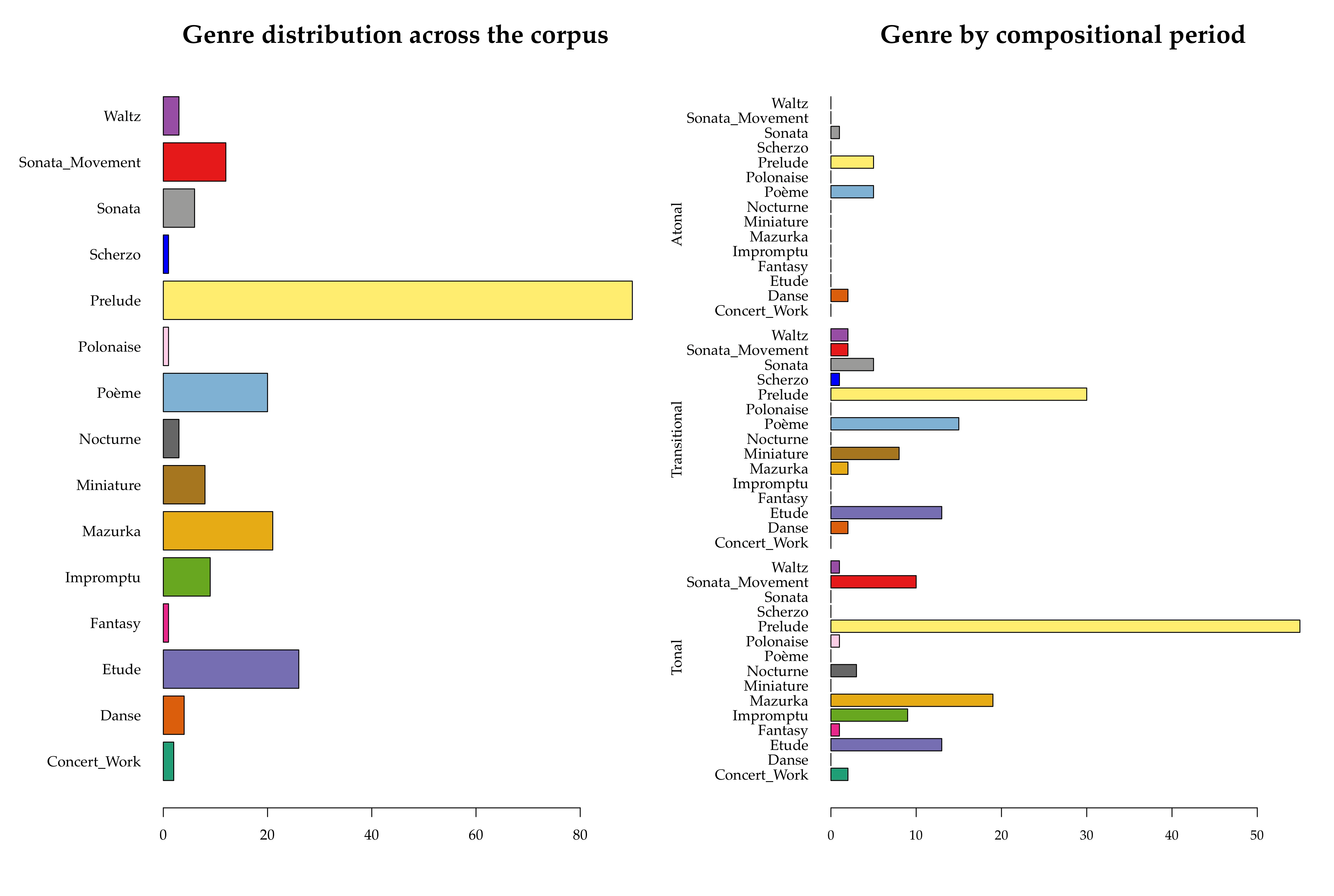
Fig. 4. Frequency distributions of genre in the Mysterium corpus. The left panel displays these distributions across the corpus as a whole, while the right panel shows these distributions grouped by compositional period. Note that the x-axis has been rescaled. The legend for both distributions is in the middle.
Despite these differences, some trends regarding genre are apparent. The young Scriabin was influenced by Chopin more than any other composer, especially in his tonal phase (Lim, 2002). This influence is apparent through the genres in which Scriabin predominantly composed: preludes (43.5%), etudes (12.6%), mazurkas (10.1%), nocturnes (1.4%), and waltzes (1.4%). Within the tonal period, these numbers are even more prevalent (preludes (50%), etudes (11%), mazurkas (16.1%), nocturnes (2.5%), waltzes (0.8%)). By the time of the atonal period, these types of pieces are completely absent except for the prelude. The prelude is the only genre in which Scriabin composed during all three periods. It is also the most abundant genre in the tonal period, and one of the top three most common genres in the transitional and atonal periods.
The poème as a solo piano work was one of Scriabin's innovations as a composer, though the genre's origins lay in the large-scale Romantic symphonic works conceived of first by Franz Liszt (Macdonald, 2001). Scriabin, too, wrote symphonic poems, namely Le Poème de l'extase, Op. 54 and the Prométhée ou le Poème de feu, Op. 60. Scriabin likely applied the term poème to his piano compositions because of the form's extramusical associations; in the Romantic era, these associations often came from literature or poetry, but in Scriabin's case the extramusical association is with his own philosophy (Ballard, Bengtson, and Young, 2017, 18). The poème is introduced during the transitional period and is one of the three most numerous forms. As can be seen in Figure 4 (Right), the poème, prelude, and single-movement sonata comprises most of Scriabin's late work after the influence of Chopin waned. (That influence was replaced musically by Wagner in addition to several philosophical and religious ideas, namely the theosophy of Helena Blavatsky.) Lastly, the single-movement sonata also appears during the transitional period, starting with the fifth sonata, and replaces the traditional multi-movement sonata.
Meter
Although Scriabin has received much scholarly attention, most of it has focused on his early adoption of post-tonality and some of his harmonic innovations (e.g., Wai-Ling (1996) discusses octatonicism; Billam (2011) discusses scales derived from the octatonic scale, and Kallis (2008) discusses quartal harmony and the relationship between harmony and the octatonic scale in Scriabin's music.) Throughout this literature, Scriabin's pitch organization is central, and meter is often either overlooked or mentioned in a purely descriptive manner.
Yet, Scriabin's rhythmic and metric techniques are original and idiosyncratic. Mauchley (1982), for instance, points out the unusual predominance of triple meter and compound subdivision in Scriabin's preludes. Huron (2006) surveyed a large sample of Western classical music and found that binary organization, including simple meter and duple and quadruple meter, are most common in classical music, deviating notably from Scriabin's practice. Huron also discusses cognitive research that suggests a bias towards binary metric constructs. London (2012) also mentions different explanations that have been offered for the binary bias, such as human bipedalism.
Another unique element of Scriabin's rhythmic practice involves the sometimes ambiguous notation of rhythms. Hook (2011) explores such notations specifically in the Prelude, Op. 11, No. 1. Vojcic (2008) argues for Scriabin's possible use of time signatures to explicitly notate rubato. Given his unique contributions, Scriabin's use of rhythm and meter deserves systematic attention, specifically the abundance of ternary metric organizations—beats that group three subdivisions and measures that group three beats (Bell, 2022).
The first task was simply to survey Scriabin's use of notated time signatures. Figure 5 catalogs Scriabin's use of notated time signatures, grouped by compositional period.
The most frequently distributed time signatures are labeled on the graph, above each bar. As is immediately apparent, ternary time signatures like 3/4 and 3/8 (simple triple meters) and ternary subdivisions in meters like 6/8, 9/8, and 12/8 (compound meters) are the most common across the three periods. These trends are consistent with the anecdotal evidence cited in Mauchley (1982) of the unusual predominance of triple and compound meters in Scriabin's music. Together, simple triple and compound meters represent a remarkable 67.1% of the 262 total time signatures used. Even after removing all dance genres conventionally notated in triple meter (i.e., mazurkas, waltzes, the polonaise, and the scherzo), triple and compound meters still represent 63.6% of all remaining 233 time signatures used. These ratios are substantially higher than typical usages in common-practice music (Huron, 2006).
To further explore meter usage, we categorized each time signature into one of four types, shown in Table 2: simple, compound, asymmetrical, and symmetrical.
| Time signature type | Count | Percentage |
|---|---|---|
| Simple | 160 | 69% |
| Compound | 60 | 26% |
| Asymmetrical | 10 | 4% |
| Symmetrical | 3 | 1% |
The simple and compound categories are already familiar. The asymmetrical category includes time signatures such as 5/8 that group beats of different numbers of subdivisions (3+2 or 2+3 for 5/8). We created the symmetrical category for time signatures such as 15/8 (used in Prelude, Op. 11, No. 14) in which each measure groups three beats and each beat groups five eighth notes. As in simple and compound time signatures, the beats in a symmetrical time signature are of the same length, but the number for grouping subdivisions is not two or three. In the case of Scriabin, every meter in the symmetrical category uses subdivisions of five. The graph in Figure 6 shows counts for the four categories grouped by compositional period. As can be seen in Figure 6, simple meters are the most prevalent in every period, followed by compound meters. Asymmetrical and symmetrical meters are most common in the transitional period, but the lack of those meters in the atonal period may simply be a result of small sample size.
Harmony
Much of the scholarship about Scriabin's music focuses on his harmony, scale usage, and gradual embrace of atonality. (See the literature review above.) While an exhaustive examination of his harmonic practice is beyond the scope of this article, a few preliminary observations can be made about some of the well-discussed harmonic elements of Scriabin's vocabulary.
DOMINANT SEVENTH CHORD WITH LOWERED FIFTH
In the introduction to his seminal set-theoretic analysis of Scriabin's music, James Baker (1986) discusses the development of Scriabin's harmonic language across the three compositional periods mentioned above: tonal, transitional, and atonal. Specifically, he mentions that a hallmark of the transitional style is Scriabin's adoption of the dominant seventh chord with a lowered fifth (i.e., V7b5) in place of the traditional dominant seventh with a perfect fifth above the root. The V7b5 comprises two interlocked tritones (from root to fifth and from third to seventh), a quintessential interval in post-tonal music. This harmony is enharmonically equivalent to the French augmented sixth chord (French +6). However, V7b5 functions primarily as a dominant harmony, leading back to tonic, whereas the French +6 primarily functions as a predominant before resolving to a dominant chord. See Figure 7 below for an example of both harmonies.
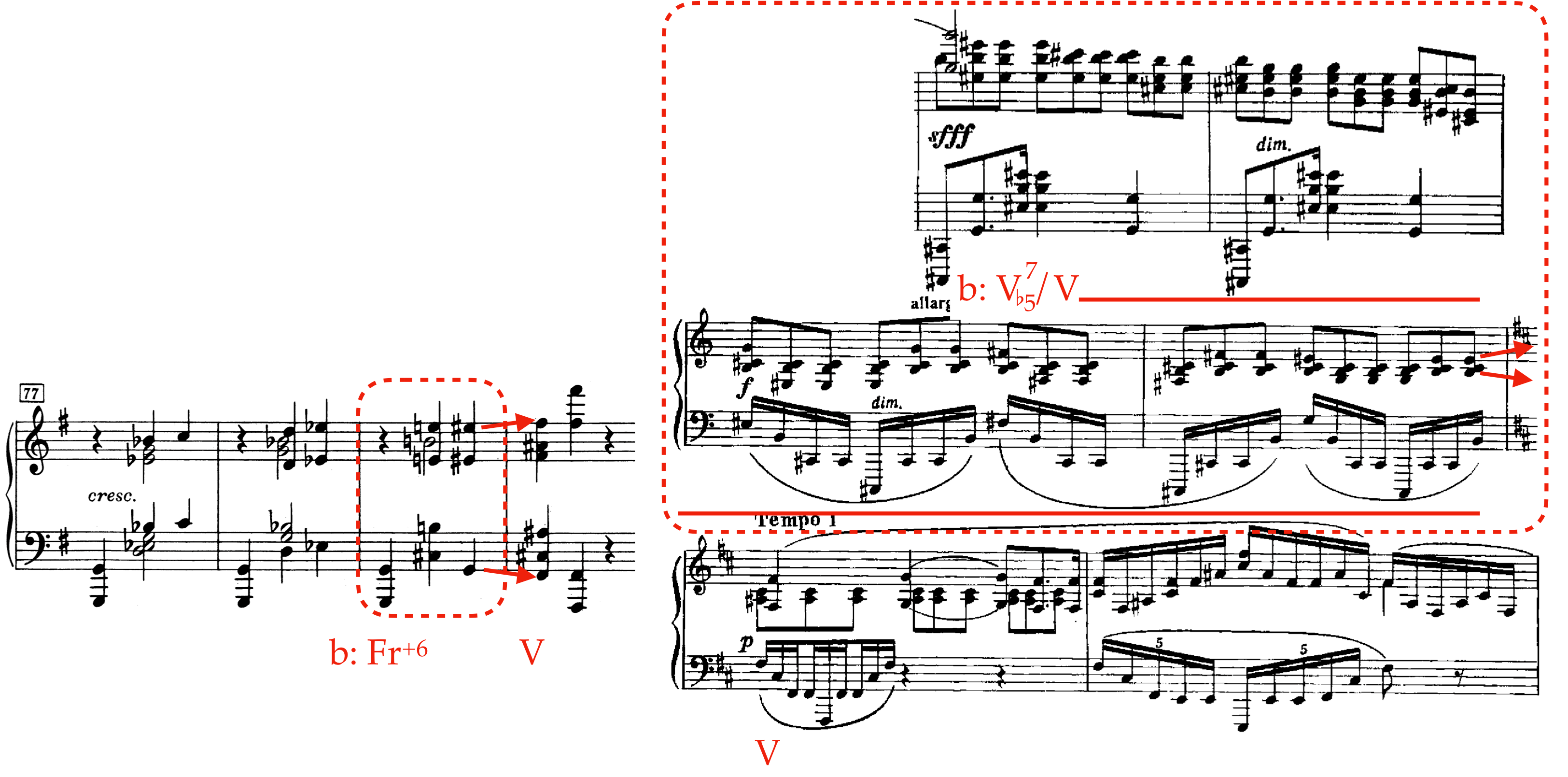
Fig. 7. An example of the French augmented sixth chord (left) and V7b5 (right), both in the context of B minor. The French augmented sixth chord resolves outward to the dominant pitch (F-sharp) by half-step. The V7b5 resolves like a typical V7 chord, but the fifth has been lowered (G-natural instead of G-sharp). (N.B., the E-natural in the left of the figure and the F-sharp in the right of the figure are non-chord tones.) The left example is from Mazurka, Op. 3, No. 1, mm. 77–80. The right example is from Fantasie, Op. 28, mm. 91–92.
This difference of function leads to a typical difference in spelling. The French +6 chord is marked by scale degree 6 (lowered 6 in major) and raised scale degree 4, along with scale degrees 1 and 2. In part, due to its predominant function, the normative spelling of the chord places scale degree six in the lowest voice, creating the augmented sixth interval with raised scale degree 4. Although "inversions" placing raised scale degree 4 below scale degree 6 are possible, in which the interval would be inverted to a diminished third, this is unusual and would be marked as an exception to traditional practice. However, in the V7b5 chord, scale degrees 7 and lowered 2 can much more commonly create a diminished third interval between them, when scale degree 7 is voiced lower than scale degree 2. Even though augmented sixth intervals are possible when voiced with scale degree 7 higher, the diminished third is one way to typically signal V7b5 instead of the French +6.
Using the Mysterium corpus, we examined the proportion of all harmonies used in Scriabin's music that were either the French +6 or V7b5. Because these two chords are enharmonically identical, a proper analysis of the use of these two chords must first establish the currently active key (if present at all) at every moment of the corpus and then determine the function of each chord to differentiate the two chords. Because such an exhaustive analysis was beyond the scope of this study, we elected to simply first identify all chords that were enharmonically equivalent to the French +6 using the Humdrum Extra (n.d.) tool sonority (http://extras.humdrum.org/man/sonority/). After extracting just French +6 chords, we examined the spelling and voicing of each chord to determine which harmonies employed notated diminished thirds (regardless of octave), which we took to be V7b5. All other harmonies contained augmented sixths without diminished thirds, which we classified as French +6 chords. Certainly, this is a problematic assumption, and is likely to erroneously classify some V7b5 as a French +6, and may possibly classify inverted French +6 chords as V7b5.
Still, the results of this survey were consistent with Baker's conjecture that V7b5 usage peaked in Scriabin's transitional period. Consider Figure 8, which plots proportions of all harmonies in a given opus that are enharmonically equivalent to French +6, but use diminished third intervals, consistent with a V7b5 harmony.
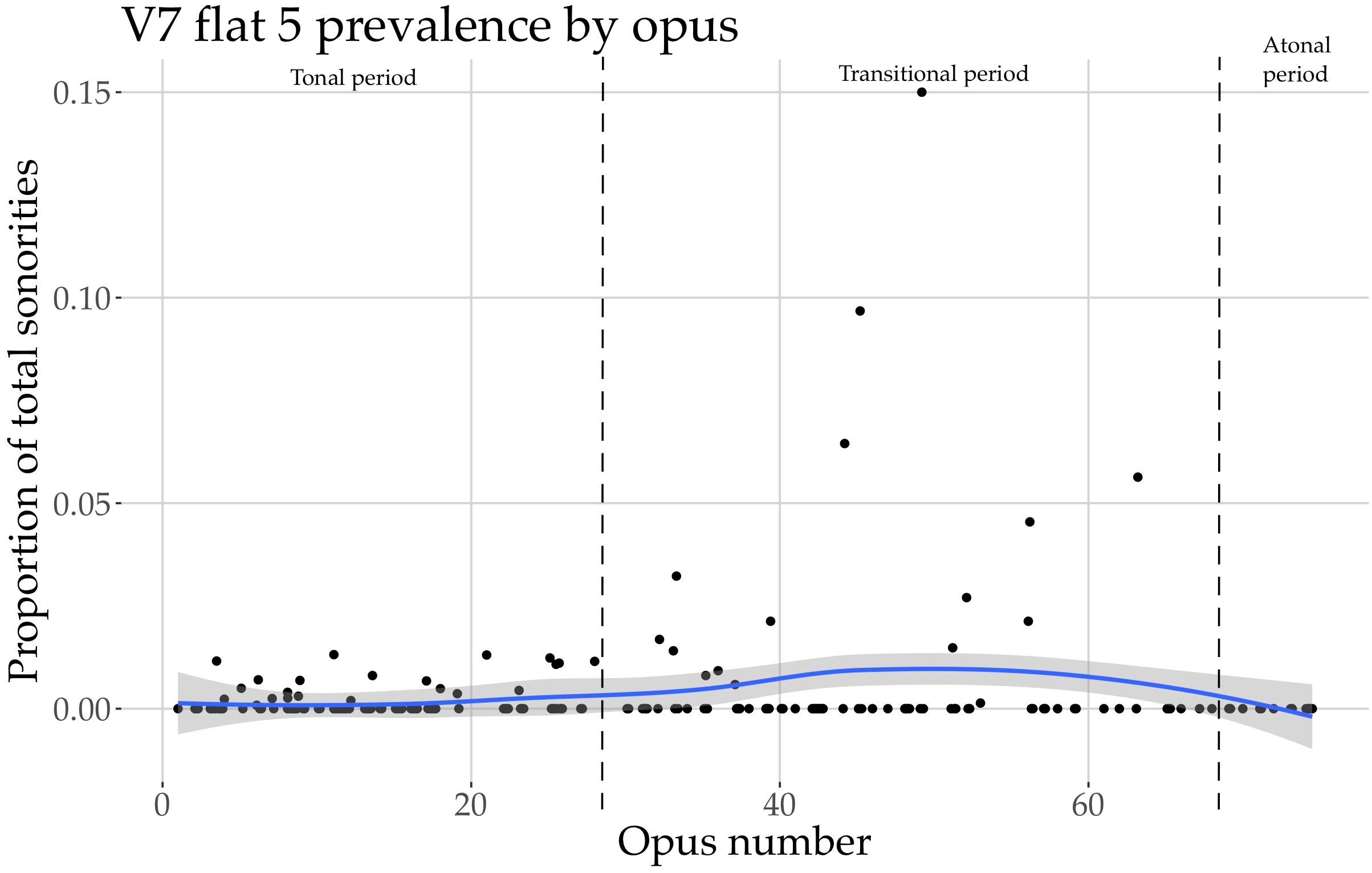
Fig. 8. Proportions of all harmonies in a given opus that are enharmonically equivalent with a French augmented sixth chord (French +6), but voiced with diminished third intervals, consistent with the dominant seventh with lowered fifth (V7b5). The vertical dashed lines roughly mark the boundaries between the three compositional periods.
The earlier tonal period shows consistent but infrequent usage of the chord, with an average of 0.75% usage. Usage increases during the transitional period up to an average 1.3%, and then decreases to no usage (0% of total chords) during the atonal period. This results in a significant ANOVA (F(2, 202) = 4.77, p = .009). Pairwise comparisons using Tukey's honest significant difference test reveal that the transitional period has significantly more usage of V7b5 than the tonal period (p = .01), but the difference between the transitional period and the atonal period are not significant, owing to the small sample size of the atonal period.
When comparing these results to the French +6 similar patterns are observable, as seen in Figure 9, which plots proportions of all harmonies in a given opus that are enharmonically equivalent to the French +6 without using a diminished third interval.
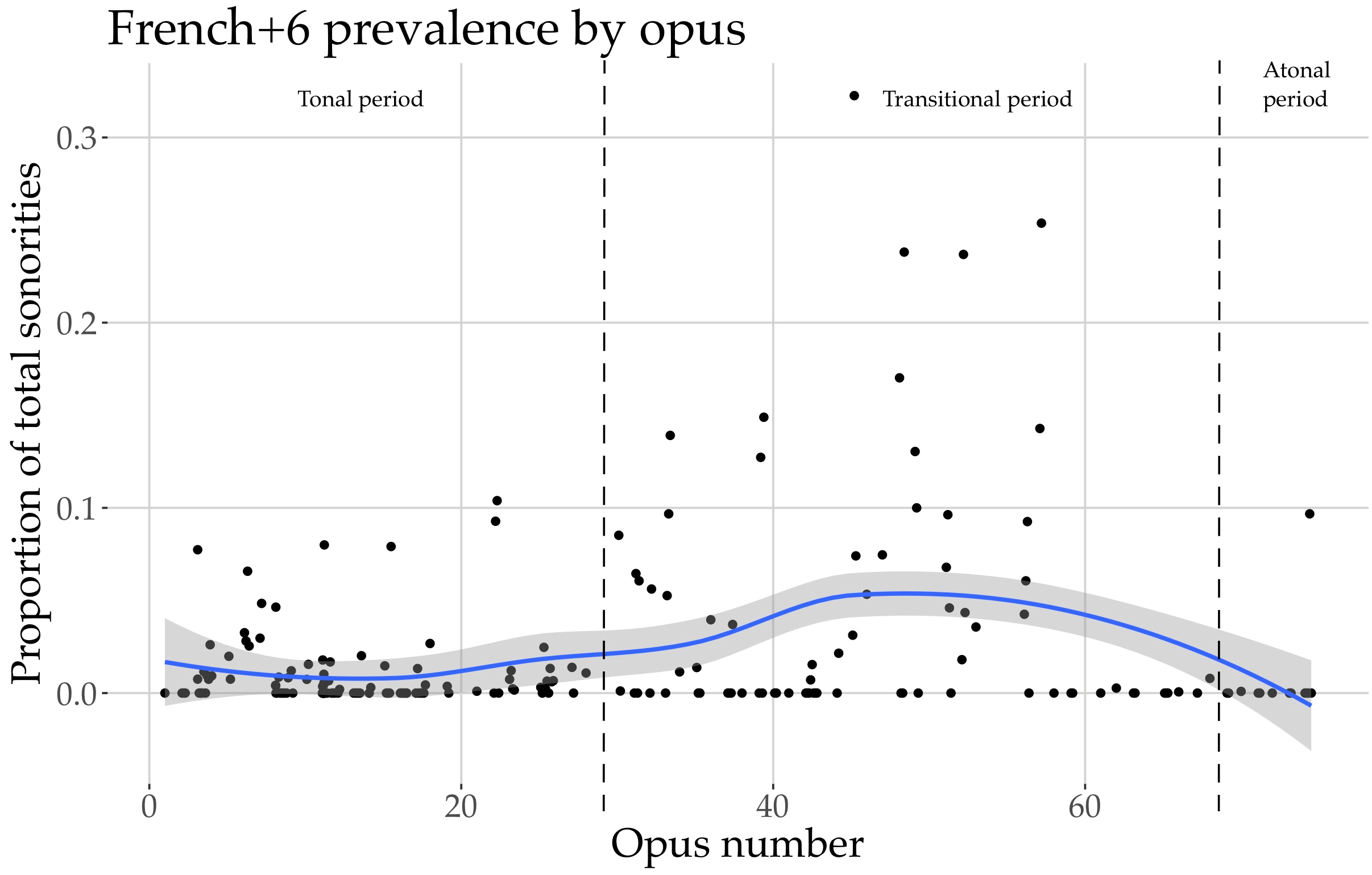
Fig. 9. Proportions of all harmonies in a given opus that are enharmonically equivalent with a French augmented sixth chord (French +6), but without a diminished third interval. The vertical dashed lines roughly mark the boundaries between the three compositional periods.
As with V7b5, the transitional period employs the greatest proportion of French +6 harmonies (4.2%), significantly higher than both the tonal (0.99%) and atonal (0.75%) periods, resulting in a significant ANOVA (F(2,202) = 12.87, p < .0001). Pairwise comparisons with Tukey's honest significant difference test show that transitional usage of French +6 is significantly higher than both the tonal (p < .0001) and the atonal (p = .027) periods.
THE MYSTIC CHORD
Perhaps the most well-known of Scriabin's innovations is his use of the "Mystic" chord. In its most common voicing, the chord is presented as a stack of various qualities of fourths. (See Kallis (2008) for a detailed analysis of Scriabin's use of quartal harmony). Specifically, from the bass pitch up are an augmented fourth, a diminished fourth, another augmented fourth, and then two perfect fourths. If the chord were built on C, this would involve the notes C-F#-Bb-E-A-D. See Figure 10 for an example.
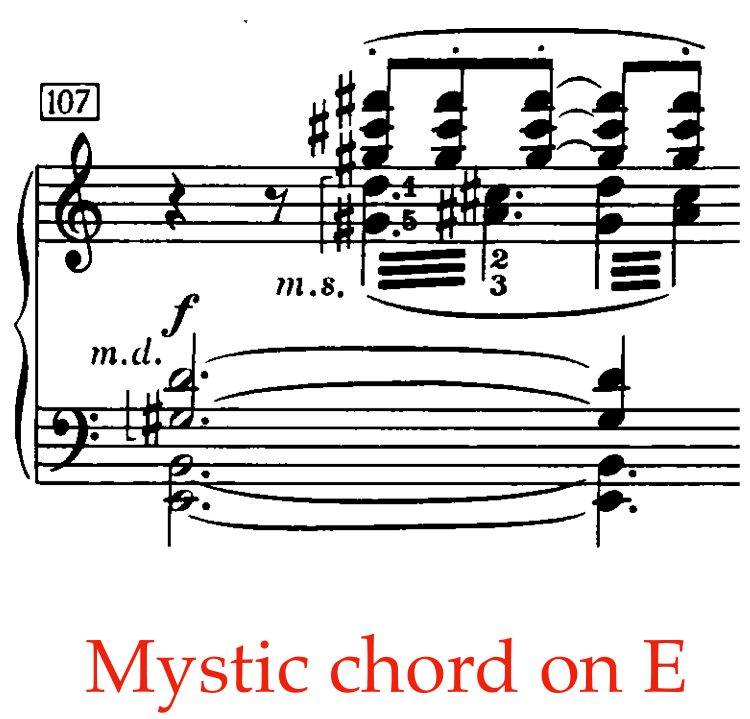
Fig. 10. An example of the Mystic chord built on E (E, A-sharp, D, G-sharp, C-sharp, F-sharp). (The B in the bass is for resonance.) Example from Vers la flamme (Towards the Flame), Op. 72, m. 107.
This chord appears to be invented by Scriabin, and is an example of one of his methods of pitch organization that he developed beginning in the transitional period. Another prominent method Scriabin used was that of non-diatonic pitch collections, especially the whole-tone and octatonic scales, from which the Mystic chord is derived. The Mystic chord may occur as the complete collection of pitch-classes sounding simultaneously, but also appears in various subsets of the complete set.
Similar to our investigation above, we examined the prevalence of the Mystic chord in Scriabin's output as a ratio of the total number of harmonies in each opus. Due to the unique intervallic content of the full hexachord, the complete harmony can be identified by its interval-class vector, a listing of all possible permutations of intervals within a set of pitch-classes, assuming octave, enharmonic, and inversional equivalence. Interval-class vectors are identified by counting the number of total interval classes from 1 semitone up until 6 semitones (or the tritone). Specifically, the complete Mystic chord uses the interval-class vector of <142422>. Many subsets of the Mystic chord are possible and do occur in Scriabin's music. For the purpose of this short survey, we decided to limit our search by just finding the complete Mystic chord's interval class vector, as well as the six subsets missing only one pitch-class. Table 3 lists the interval-class vector for the Mystic chord and its six subsets.
| Forte Number | Prime Form | Interval-class Vector |
|---|---|---|
| 6-34 (Full Mystic) | (013579) | <142422> |
| 5-28 (Subset 1) | (02368) | <122212> |
| 5-33 (Subset 2) | (02468) | <040402> |
| 5-26 (Subset 3) | (02458) | <122311> |
| 5-34 (Subset 4) | (02469) | <032221> |
| 5-24 (Subset 5) | (01357) | <131221> |
| 5-30 (Subset 6) | (01468) | <121321> |
The results of the survey, shown in Figures 11 and 12, are consistent with an increase of Mystic chord usage during Scriabin's transitional period. In Figure 11, which plots proportions of all harmonies in a given opus that use the complete Mystic chord's interval vector, uses of the Mystic chord appear to begin around Opus 40.
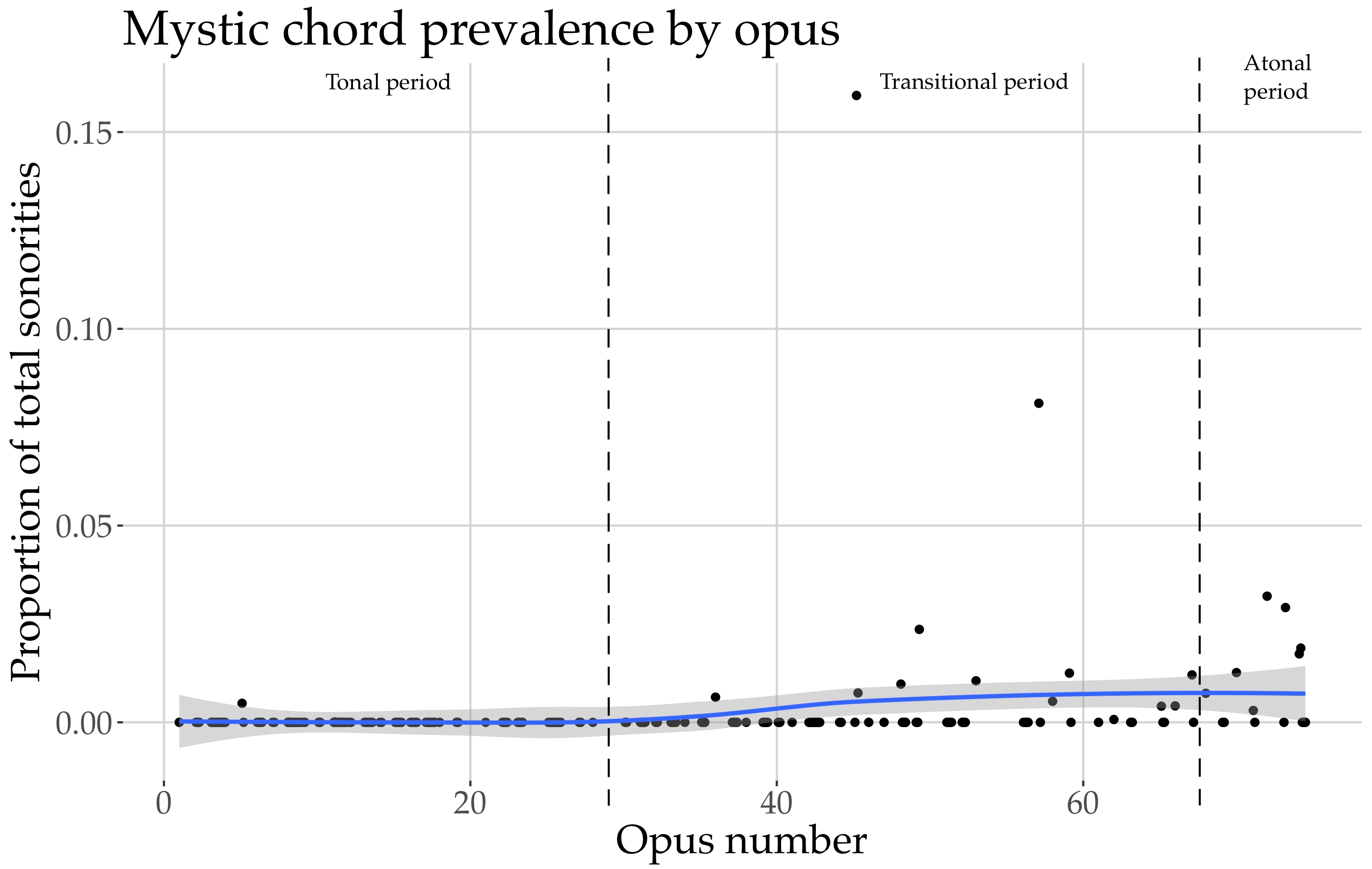
Fig. 11. Proportions of all harmonies in a given opus that use the complete interval vector <142422> for the Mystic chord.
However, it is not until later that proportions of Mystic chords become stable around 1%. There is a positive correlation between opus number and prevalence of the Mystic chord (r = +.21, t(204) = 3.13, p = .002), and there is a significant ANOVA of compositional period (F(2,203) = 4.39, p = .01). However, pairwise comparisons between the three periods using Tukey's honest significant difference test were not significant.
A much stronger relationship between opus number and Mystic chord usage was found when looking at not only the complete chord, but also all six five-pitch subsets (missing one pitch-class). Consider Figure 12, which shows a much stronger increase in Mystic chord usage starting around opus 40 in the transitional period.
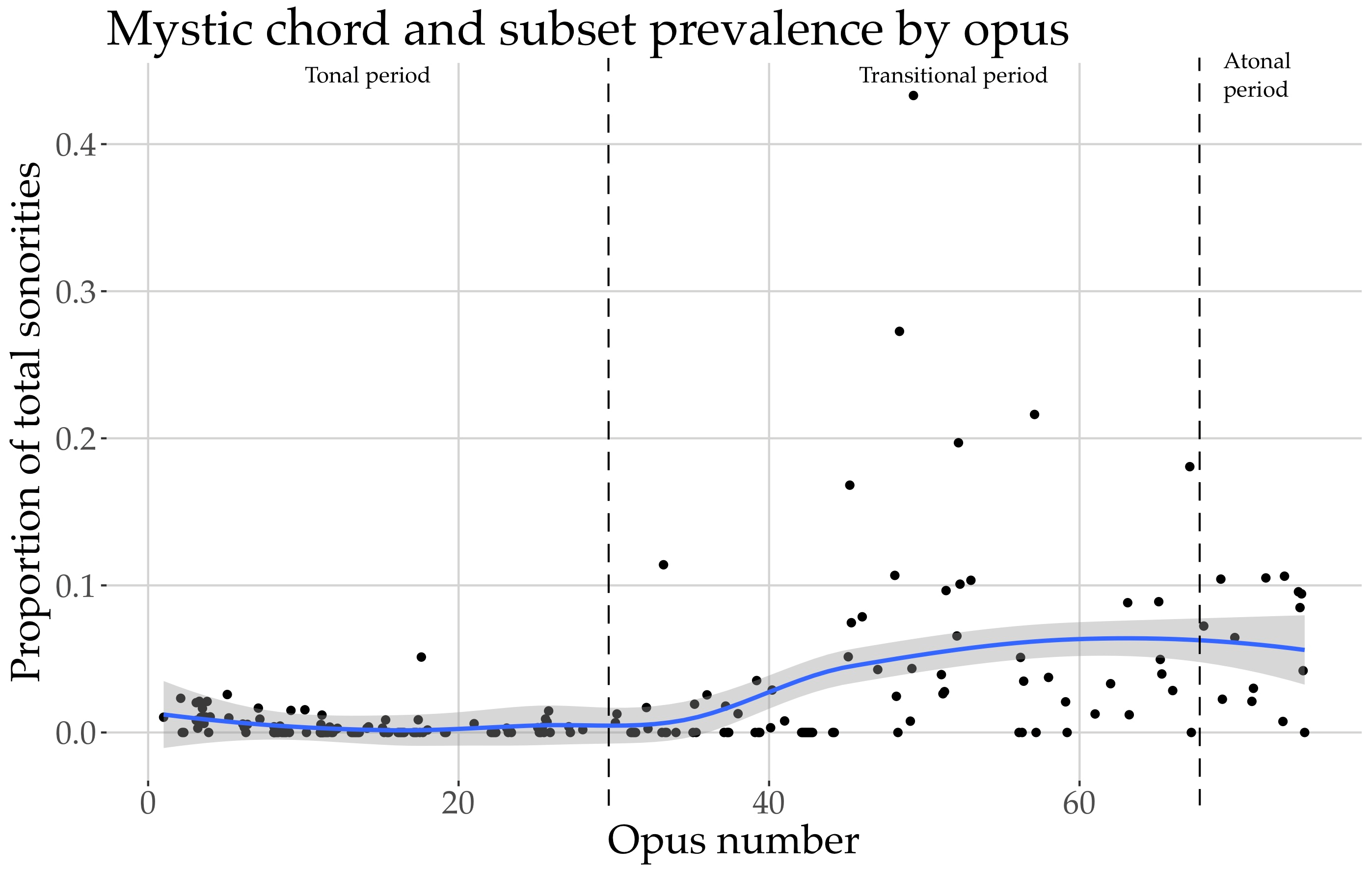
Fig. 12. Proportions of all harmonies in a given opus that use the complete Mystic hexachord and/or any of the pentachord subsets.
The remainder of Scriabin's output demonstrates fairly consistent heavy usage of the Mystic chord and its subsets, averaging 4.1% in the transitional period and 6.0% in the atonal period (compared to 0.4% in the tonal period). This results in a significant ANOVA (F(2,203) = 20.42, p < .0001), and a remarkably strong correlation between opus number of prevalence of the chord (r = +.45, t(204) = 7.19, p <.0001). Pairwise comparisons reveal significant differences between the transitional and tonal periods (p < .0001) and the atonal and tonal periods (p = .0001). These results are consistent with existing scholarship identifying a substantive increase in this sonority beginning with the transitional period (Baker, 1986).
FUTURE RESEARCH
The Mysterium corpus is a rich source of data for research into advanced rhythmic and metric phenomena and difficult tonal and atonal music, as well as music that does not obviously belong to one or the other of those two categories. It is a source of piano music, Russian music, and is a single body of repertoire that spans both common practice tonality and early post-tonality, as well as the transition between those periods. Possible applications of the corpus are boundless (though some specific pointers in the direction of metric analysis are given in the fifth chapter of Bell (2022)). Regarding the Mysterium corpus itself, plans for future work on the corpus are twofold. The first plan is to complete the encodings that already exist by adding the musical information not already encoded—tempo markings, dynamics, articulations, etc. The second plan is to complete the corpus by expanding it to include all of Scriabin published compositions, that is, to encode the symphonies, piano concerto, and Rêverie.
ACCESSING THE CORPUS
The Mysterium corpus is available at the following GitHub repository: https://github.com/bel28kent/Mysterium. We grouped the kern files into directories by opus number. The CCARH files are in a directory labeled ccarh_kern. We have also included a README.md file that lists changes made from Scriabin's original notation; it is highly recommended that this documentation be consulted before using the kern files.
ACKNOWLEDGEMENTS
This article was copyedited by Gabriele Cecchetti and layout edited by Diana Kayser.
NOTES
-
Correspondence can be addressed to: Bryan Jacob Bell, University of British Columbia, Email: bjbsga@student.ubc.ca.
Return to Text -
The first author would like to acknowledge that Figure 4, presented here, corrects an error in Figures 9 and 10 presented in Bell (2022). There are only six single-movement sonatas, not the twenty shown in Bell (2022).
Return to Text
REFERENCES
- Baker, J. (1986). The music of Alexander Scriabin. Yale University Press.
- Ballard, L., Bengtson, M., & Young, J. B. (2017). The Alexander Scriabin companion: History, performance, and lore. Rowman & Littlefield.
- Bell, B. (2022). An Inner Metric Analysis of Meter in the Music of Alexander Scriabin [Master's thesis, Kent State University]. OhioLINK Electronic Theses and Dissertations Center. http://rave.ohiolink.edu/etdc/view?acc_num=kent1650651343569665.
- Billam, P. (2011). Five Preludes, Op. 74 by Alexander Scriabin. Retrieved from https://www.pjb.com.au/mus/arr/a4/scriabin_op74.pdf.
- Bowers, F. (1996). Scriabin: A Biography. Dover Publications.
- Cohn, R. (2012). Audacious Euphony: Chromatic Harmony and the Triad's Second Nature. Oxford University Press. https://doi.org/10.1093/acprof:oso/9780199772698.001.0001
- de Clercq, T. (2022). Tempo versus average rates of harmonic rhythm in popular music: A study of three corpora. Musicae scientiae. https://doi.org/10.1177/10298649221091483
- Devaney, J., Arthur, C., Condit-Schultz, N., & Nisula, K. (2015). Theme and variation encodings with roman numerals (TAVERN): A new data set for symbolic music analysis. In Proceedings of the 16th International Society for Music Information Retrieval Conference (ISMIR), Malaga, Spain.
- Haahr, M. (2022, March 16). RANDOM.ORG: True Random Number Service. Retrieved from https://www.random.org.
- Hook, J. (2011). How to perform impossible rhythms. Music Theory Online, 17(4). https://doi.org/10.30535/mto.17.4.1
- Humdrum Extras. (n.d.). Sonority. Retrieved from http://extras.humdrum.org/man/sonority/.
- Huron, D. (2002). Music information processing using the Humdrum toolkit: Concepts, examples, and lessons. Computer Music Journal, 26(2), 11–26. https://doi.org/10.1162/014892602760137158
- Huron, D. (2006). Sweet anticipation: Music and the psychology of expectation. MIT Press. https://doi.org/10.7551/mitpress/6575.001.0001
- Igumnov, K., & Milstein, Y. (1948). A.N. Skryabin: Polnoe sobranie sochinenii dlia fortepiano. Muzgiz.
- Kallis, V. (2008). Principles of pitch organization in Scriabin's early post-tonal period: The piano miniatures. Music Theory Online, 14(3). https://doi.org/10.30535/mto.14.3.2
- KernScores. (n.d.). Search results for Scriabin: 13 items. http://kern.humdrum.org/search?s=t&keyword=Scriabin.
- Lim, S.A. (2002). The influence of Chopin in piano music on the twenty-four preludes for piano, opus 11 of Alexander Scriabin (Publication No. 3050069) [Doctoral dissertation, Ohio State University]. ProQuest Dissertation Publishing.
- London, J. (2012). Hearing in time: Psychological aspects of musical meter (2nd ed.). Oxford University Press. https://doi.org/10.1093/acprof:oso/9780199744374.001.0001
- London, J. (2013). Building a representative corpus of classical music. Music Perception, 31(1), 68–90. https://doi.org/10.1525/mp.2013.31.1.68
- London, J. (2022). A bevy of biases: How music theory's methodological problems hinder diversity, equity, and inclusion. Music Theory Online, 28(1). https://doi.org/10.30535/mto.28.1.4
- Mauchley, G. J. (1982). The Preludes for Solo Piano by Alexander Scriabin (Publication No. 10296692) [Doctoral dissertation, Indiana University]. ProQuest Dissertation Publishing.
- Macdonald, H. (2001). "Symphonic poem." Grove Music Online. https://doi.org/10.1093/gmo/9781561592630.article.27250
- Moss, F., Souza, W. F., & Rohrmeier, M. (2020). Harmony and form in Brazilian Choro: A corpus-driven approach to musical style analysis. Journal of New Music Research, 49(5), 416–437. https://doi.org/10.1080/09298215.2020.1797109
- Neuwirth, M., Harasim, D., Moss, F. C., & Rohrmeier, M. (2018). The Annotated Beethoven Corpus (ABC): A dataset of harmonic analyses of all Beethoven string quartets. Frontiers in Digital Humanities, 5(16). https://doi.org/10.3389/fdigh.2018.00016
- Philipp, G. (1967–1972). Alexander Skrjabin: Ausgewählte Klavierwerke. Edition Peters.
- Samson, J. (1977). Music in Transition: A Study of Tonal Expansion and Atonality, 1900–1920. W.W. Norton.
- Sapp, C. (2017a, March 3). Verovio humdrum viewer documentation. Humdrum. Retrieved from https://doc.verovio.humdrum.org/.
- Sapp, C. (2017b, June 20). craigsapp/musicxml2hum. Retrieved from https://github.com/craigsapp/musicxml2hum.
- Savage, P. (2022). An overview of cross-cultural music corpus studies. In The Oxford Handbook of Music and Corpus Studies, C34.S1–C34.N1. Oxford University Press. https://doi.org/10.1093/oxfordhb/9780190945442.013.34
- Schloezer, B.d. (1987). Scriabin: Artist and mystic (N. Slonimsky, Trans.). University of California Press.
- Smith, K. M. (2013). Skryabin, philosophy and the music of desire. Ashgate.
- Vojcic, A. (2008). Approximate and convenient time signatures: Rubato notation in Alexander Scriabin's early preludes. In Music Theory and Interdisciplinarity: 8th Congress of the Gesellschaft für Musiktheorie, Graz, 351–362. https://doi.org/10.31751/p.81
- Wai-Ling, C. (1996). Scriabin's octatonic sonata. Journal of the Royal Musical Association, 121(2), 206–228. https://doi.org/10.1093/jrma/121.2.206
- Yekimovsky, V. (1997). Alexander Skryabin: Complete Works for piano. Könemann Music Budapest.
- Zarafiants, E. (2000). Scriabin: Preludes, Vol. 2. Accessed through the Naxos Music Library, Catalogue No. 8.554145.

